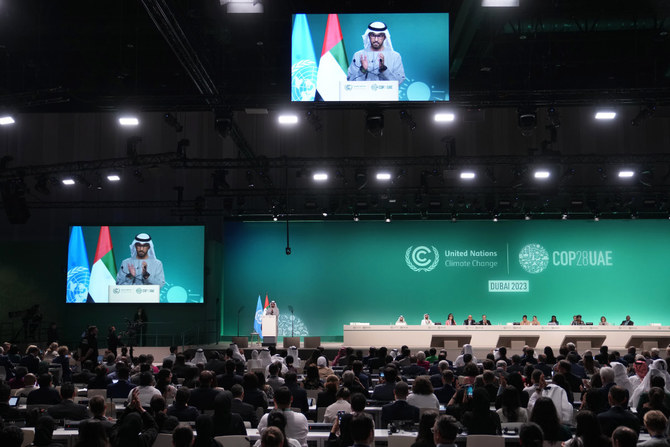COP28 — a step in the right direction

https://arab.news/nm26f
Negotiators at COP28 reached a consensus to eventually transition away from fossil fuels to reach net zero by 2050. They burned the midnight oil to deliver a final deal after the official end of the conference. That is nothing new in the delicate multilateral negotiations at the UN Framework Convention on Climate Change.
This year’s UN climate talks were held in Dubai with Sultan Al-Jaber as its president. Despite criticism by many Western nations and nongovernmental organizations for his association with the oil sector, Al-Jaber proved that he could deliver a deal with which most countries could live. We should not forget that while Al-Jaber is the CEO of the state oil company ADNOC, he is also chairman of Masdar, the UAE’s renewables champion.
Up until Tuesday, when the conference was supposed to end, it looked very much that common language could not be found. The sticking point was how to word an eventual phasing out of the use of fossil fuel. The overall goal of the UNFCCC is to achieve the Paris goal of limiting global warming to 1.5℃ above pre-industrial times.
The latest statistic, which was released in the World Meteorological Organisation’s Provisional State of the Global Climate Report 2023, showed that during the first 10 months of the year, temperatures were at disconcerting 1.4 ℃ above pre-industrial levels might have helped bring a sense of urgency to the negotiations.
In the end, negotiators agreed on the following language: “Transitioning away from fossil fuels in energy systems, in a just, orderly and equitable manner, accelerating action in this critical decade, so as to achieve net-zero by 2050 in keeping with the science.”
Both oil and gas-producing nations and the “climate hawks” hailing from the Organisation for Economic Co-operation and Development and NGOs could live with this language. The wording was hard fought over. Nobody was 100 percent happy, but such is the nature of a compromise, everybody gets something and nobody gets everything.
So, what does this deal mean?
German climate envoy Jennifer Morgan pointed out that the deal will send a signal to investors. On the one hand, this is good. There may, however, also be an inherent danger in how investors feel incentivized by the deal. The world still needs fossil fuels (particularly gas) during the transition. If the sector is starved of capital resulting in a lack of barrels and or BTUs, it may hinder the quest for development and the fight against energy poverty — particularly in parts of the Global South.
This is where the quest for a “just and orderly energy transition” comes in.
This COP28 was the most inclusive of all the COPs held since the inception of the conference of the parties (which is what the acronym stands for) as it brought the fossil fuel industry to the table. It is important to treat all industries as part of the solution and not singling out one as the enemy.
Cornelia Meyer
There was the goal to triple renewable power and double energy efficiency by the end of the decade, which is no small feat, but which might have helped bring some of the OECD nations over the line. The negotiators also acknowledged nuclear energy and carbon capture utilization and storage had a role to play.
This COP28 was the most inclusive of all the COPs held since the inception of the conference of the parties (which is what the acronym stands for) as it brought the fossil fuel industry to the table. It is important to treat all industries as part of the solution and not singling out one as the enemy. Climate change is the global problem of our generation and as such deserves truly global, inclusive, and interdisciplinary solutions.
We will not achieve eradicating energy poverty, providing energy security to all, and saving the environment without getting all the relevant players in the room.
This also pertains to the North-South debate: Equity and fairness are very important in terms of ensuring that the Global South is given the space to develop its economies and bring people out of energy poverty. By 2050, the world’s population will have grown by 2 billion and they will live in the Global South.
The loss and damages fund aiming at supporting the most vulnerable countries in dealing with the effects of climate change is important in that context as is the fact that for the first-time developed countries lived up to their promise of a yearly contribution of $100 billion toward helping developing nations with energy transition — a drop in the ocean, but still better than what has been achieved before.
Furthermore, while tripling renewable energy and doubling energy efficiency are laudable goals and working toward eventually phasing out fossil fuels may sound good to some. All of the above depends on countries and organizations not just talking the talk but also walking it. The Glasgow promises to phase out coal did not bear fruit. As a matter of fact, coal consumption has increased since 2021.
This brings us to the last point. All countries need to contribute equitably. India and China’s net-zero goals are 2070 and 2060 respectively. They are both large emitters and their collaboration will be needed to reach the ambitious goals set out in this year’s COP communique.
There is a North-South divide on how nations prioritize climate change and economic considerations. That divide could be narrowed at this COP, but let there be no mistake — it still exists.
• Cornelia Meyer is a Ph.D.level macroeconomist, energy expert and CEO of Meyer Resources, a business consultancy.









































